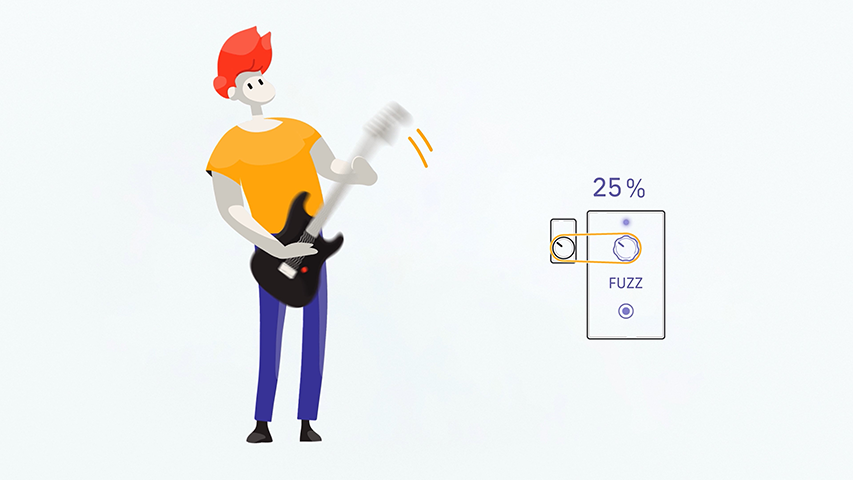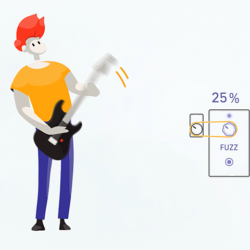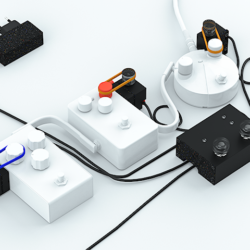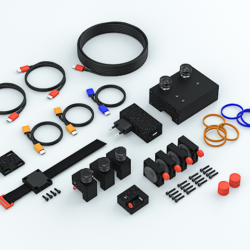KĀHEA
Description
KĀHEA is a motion control for effect pedals. The guitarist's movement is recorded with a gyroscope sensor, which is attached to the headstock of the guitar. This triggers the movement of a servo motor which, attached to the effect pedal, drives a belt that changes a parameter of the effect pedal. The belt can be connected to any parameter as desired. Different movement sequences can be added to the system with the control unit and KĀHEA reacts to the individual movement.What is the Topic?
This diploma thesis started with the term 'fun'. But what is fun? How can it be defined? What are actions that bring fun and pleasure? And what are products or devices that make you have fun? Products that require or allow playful handling are particularly predestined to evoke fun and enjoyment. The invitation to experiment can make the user of a game aware of various possibilities and possibly alternatives. Musicians are always on the lookout for a new sound, always experimenting with sounds, playing techniques or effects. This phenomenon is particularly common among guitarists. Electric guitars have a certain advantage in this respect. The outgoing signal is electronically amplified and can be modulated by various effects before it is amplified. So-called effect devices are connected between electric guitar and amplifier for this purpose. Also with regard to the way of playing it can be stated that guitarists experiment with different movements, e.g. to give the produced sounds a desired expression on a stage and for this purpose they perform rhythmic movements for example. This raises the question to what extent movement and tone modulation can be rethought in a new way for guitarists. The idea behind it originates from the thought to support the joy of experimentation of guitarists and to develop a product which expands the corresponding creative freedom. Guitarists use playing techniques, effects and movement to give the sound the desired expression. But what would happen if playing style, effects and movement influenced each other by making them dependent on each other? This is where the idea of combining playing technique and movement with effects comes from. The concept builds on existing effect pedals to create a platform for experimentation. It should be inclusive and connect to already existing ones in order to expand its function. A motor, which can be easily attached to the effect pedals, controls the potentiometer movement by means of a belt. Playing or movement is used to generate information that stands for a certain movement of the motor. For example, an up and down movement with the guitar can trigger a rotational movement of the motor, so that the associated parameters of a pedal can be controlled. This interaction is especially intended to allow guitarists to experiment while playing. This creates a connection between expression through movement and the sound, which is changed by the corresponding parameters.
Why does it look like this?
KĀHEA FXC-01 (Effect conductor) includes several components. There is a control unit, a power supply, three motors, four suction cups, a sensor, a belt adapter, an angle adapter, seven rubber belts, two potentiometer clips, three 30cm cables, two 45cm cables, a 5m cable and screws to connect the components. The color codes work as indicators for different functions. Blue and yellow represent the two control chains; red stands for other functions such as tightening the suction cup or buckle on the strap to attach the sensor to the guitar. The shape of the individual components results from the conceptual idea of designing KĀHEA in such a way, that it can be combined as easily as possible with existing equipment. Decisive parameters were the diversity of guitar headstock shapes and effect pedal shapes. Furthermore, the system should be as small as possible in order to take up as little space as possible in the context of so-called pedalboards, on which many effect pedals are mounted side by side. But also the manufacturing processes of the chosen materials have had their influence on the design.
What is special?
KĀHEA transforms the motion of the guitarist into a movement on the effect pedal. That's how the motion influences the sound and expression of the music. Experimenting with this type of interaction is intended to create new expression room for the user. But also the design of the mounting methods and the decision to use an interface that allows the user to develop his own mounting methods is a special aspect.
What is new?
The use of movement as an influence on the sound effects, i.e. the type of interaction.




